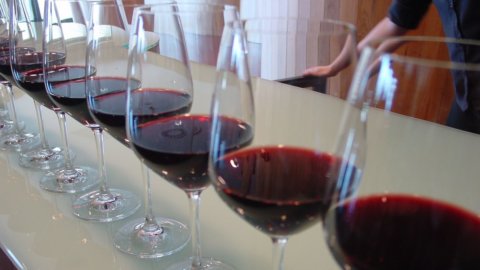Mediobanca's Research Area today presents the annual update of the survey on the Italian and international wine sector which analyzes aggregate volumes for the 2012-2016 period, supplemented with interviews with companies for 2017 pre-final data and sales expectations of 2018. The survey is made up of two sections: in the first 155 Italian companies with a turnover exceeding 25 million euros are analysed; the second examines the 15 main international listed companies with a turnover of over 150 million euros and describes the dynamics of the world stock exchange index of listed wine companies between 2001 and 2018.
In 2017, the turnover of Italian companies increased (+6,5% on 2016) thanks to the good performance of exports (+7,7%), with the boom in trade with Asia (+21,1%), but also to the contribution of domestic sales (+5,2%). Employment increases (+1,8%), investments continue to grow (+26,7%) and there is optimism on sales expectations for 2018. The spearheads of the industry are confirmed by the Veneto and Tuscan companies. The aggregate of the 15 largest listed international producers is also growing.
Revenues increase thanks to exports and the domestic market, with employment growth. Positive expectations for 2018
The pre-final data for 2017 of the Italian wine sector show a growing sector for the eighth consecutive year (+6,5% compared to 2016). This is the largest increase in the last 5 years. Once again in 2017, exports represented the driving force for sales (+7,7% on 2016), in a context in which the domestic market also provided a decisive contribution (+5,2%). "Sparkling wines" (+9,9% on 2016) are growing more than "non-sparkling wines" (+5,6%) and also in terms of employment, the world of wine records an increase, with a +1,8 % compared to 2016.
What are the forecasts for 2018? In line with the plus sign of the main indicators, sales expectations for 2018 remain positive: 93% of the companies surveyed expect not to suffer a decline in sales in the current year, while only 7% expect a decline in revenues. 17,4% even believe that growth will exceed 10%.
The performance of the top players in 2017
The three largest producers by turnover in 2017 were the Cantine Riunite-GIV group (€594 million, +5,1% on 2016), Caviro (€315 million, +3,9%) and Antinori (€221 million, + 0,4% on 2016). They follow Zonin, which achieved 4,2% growth reaching €201 million, and Fratelli Martini at €194 million (+13,3%). Seven companies achieved an increase in revenues of more than 2017% in 10: La Marca (+30,7%), Farnese (+28%), Ruffino (+15,5%), Enoitalia (+14,5%), Contri (+14,1%), Fratelli Martini (+13,3%) and Mezzacorona (+13,1%).
Some of the companies reviewed have one almost total share of foreign turnover, such as Botter with 96%, Ruffino with 93,3%, F.lli Martini with 89,9%, Mondodelvino (85,4%), Zonin with 85,1%, La Marca and Schenk both 82,7%, Farnese with 81,9% and the Cavit cooperative (80%). Only eight groups have an export share of less than 50% of sales.
Asia growing, but EU remains the main market
As far as foreign markets are concerned, in 2017 the most dynamic area was the Asian one (+21,1% sales over 2016), where, however, only 4,2% of exports are made. South America is also growing (+20,1%), despite representing just 1,4% of the foreign turnover of Italian wineries. EU countries represent the main outlet market and concentrate 53,4% of exports, with a growth of 8,6% compared to 2016. Africa, the Middle East and non-EU European countries accounted for 9,1% of total (growth of 5,8%) and North America grew by 5,7% for a share of 31,9%. Overall, Italian wine exports grew in 2017 by 7,7% over 2016.
The best performing ones are from Veneto and Tuscany
The ranking of producers based on the strength of their balance sheets - based on a summary indicator of economic and financial performance in 2016 - sees the presence among the top ten companies of as many as six producers from the Veneto, three from Tuscany and one from Piedmont, with Villa Sandi, Mionetto, Vinicola Serena and Botter with the best scores, followed by Masi, the Tuscan Ruffino and Santa Margherita. Also in 2017 the Tuscan and Veneto companies are confirmed in the lead for profitability (profit on turnover) with Antinori at 25%, Frescobaldi at 20,5%, Santa Margherita at 17,2%, Ruffino at 15,7% followed by Botter (8,6%), Mionetto (5,7%) and Villa Sandi (5,5%)
The Veneto companies excel, above all in terms of income (roi at 9,4% against 6,8% nationally; roe at 11,4% against 7,9%); the Tuscan ones also perform well (roi at 8,7% and roe at 8,4%) which appear financially solid (financial debts at 33,2% of equity against 63,4% nationally), efficient (labour cost per unit of product at 44,4% against 58,6%) and export oriented (64,4% against 51,4%).
What are the most used distribution channels?
Large-scale distribution (Gdo) prevails, involving 38,2% of production, followed by wholesalers and intermediaries at 16,8%, by Ho.Re.Ca. with 16,5% and from the direct network with 12,6%. On foreign markets, the importer intermediary dominates (74,5%).
How is the market of the international big 15 moving?
The data relating to 2016 of the aggregate of the 15 major listed international producers show an increase in turnover of 5,8% and an increase in the incidence of industrial margins on sales: EBITDA at 26,1% (13,4% for the Italians) and Mon to 22,6% (9,9% Italians), although the sector's employment fell by 2,9%. Also analyzing the most recent interim reports relating to 2017, we observe a rise in total turnover of 1,8%, with increases generalized to all companies, with the exception of the French Lanson-BCC (-7,6%) and Laurent Perrier ( -3,1%) and the Chilean Viña Concha Y Toro (-4,5%) and Viña Santa Rita (-1,5%). The Mon increased overall by 3,3%, with the three Chilean companies however showing significant decreases, also extended to the level of net income; they were affected by the poor harvest in 2017, with the consequent rise of about 23% in the cost of grapes and wine, in addition to adverse currency trends.
Bag of wine, a continuous toast
Investing in wine listed on the stock exchange continues to be an excellent business: the capitalization of the securities that make it up the World Wine Exchange Index increased by 12,2% between March 2017 and March 2018. But if the reference time horizon is broadened, the numbers are much better: since January 2001 the total return version of the world stock market index for the wine sector (including distributed dividends) has grown by 719,6%, to above world stock exchanges (+148%); the best performance in relative terms (i.e. net of the dynamics of the national Stock Exchanges) was achieved by companies in North America (+744,6%), Australia (+163,5%) and France (+100%) , while in other countries the wine companies returned less than the national stock exchange: Chile -40,1% and China -73,4%. The listed Italians remain two. If unlisted companies chose the Stock Exchange, they would see their equity valued on average by 70% more.
The complete survey is available for download on the website www.mbres.it.





